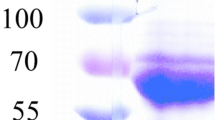Abstract
A cDNA encoding for laccase (Lcc1) was isolated from the ligninolytic fungus Trametes versicolor by reverse transcriptase polymerase chain reaction. The Lcc1 gene was subcloned into the Pichia methanolica expression vector pMETαA and transformed into the P. methanolica strains PMAD11 and PMAD16. The extracellular laccase activity of the PMAD11 recombinants was found to be 1.3-fold higher than that of the PMAD16 recombinants. The identity of the recombinant protein was further confirmed by immunodetection using the Western blot analysis. As expected, the molecular mass of the mature laccase was 64.0 kDa, similar to that of the native form. The effects of copper concentration, cultivation temperature, pH and methanol concentration in the BMMY on laccase expression were investigated. The laccase activity in the PMAD11 recombinant was up to 12.6 U ml−1 by optimization.







Similar content being viewed by others
References
Cassland P, Jönsson LJ (1999) Characterization of a gene encoding Trametes versicolor laccase A and improved heterologous expression in Saccharomyces cerevisiae by decreased cultivation temperature. Appl Microbiol Biotechnol 52:393–400
Choi J, Kim EE (2002) Expression of the active human and duck hepatitis B virus polymerases in heterologous system of Pichia methanolica. Antivir Res 55:279–290
Fahraeus G, Reinhammar B (1967) Large scale production and purification of laccase from the fungus Polyporus versicolor and some properties of laccase. Acta Chem Scand 21:2367–2378
Gianfreda L, Xu F and Bollag JM (1999) Laccase: a useful group of oxidoreductive enzymes. Biores J 3:1–25
Jönsson L, Saloheimo M, Penttila M (1997) Laccase from the white-rot fungus Trametes versicolor: cDNA cloning of lcc1 and expression in Pichia pastoris. Curr Genet 32:425–430
Kojima Y, Tsukuda Y, Kawai Y, Tsukamoto A, Sugiura J, Sakaino M, Kita Y (1990) Cloning, sequence analysis, and expression of ligninolytic phenoloxidase genes of the white-rot basidiomycete Coriolus hirsutus. J Biol Chem 265:15224–15230
Messerschmidt A (1993) Blue copper oxidases. Adv Inorg Chem 40:121–185
Roy-Arcand L, Archibald FS (1991) Direct dechlorination of chlorophenolic compounds by laccases from Trametes (Coriolus) versicolor. Enzyme Microb Technol 13:194–203
Thurston CF (1994) The structure and function of fungal laccase. Microbiology 140:19–26
Yaver DS, Xu F, Golightly EJ, Brown SH, Rey MW, Schneider P, Halkier T, Mondorf K, Dallboge H (1996) Purification, characterization, molecular cloning and expression of two laccases from the white rot basidiomycete Trametes villosa. Appl Environ Microbiol 62:834–841
Author information
Authors and Affiliations
Corresponding author
Rights and permissions
About this article
Cite this article
Guo, M., Lu, F., Du, L. et al. Optimization of the expression of a laccase gene from Trametes versicolor in Pichia methanolica . Appl Microbiol Biotechnol 71, 848–852 (2006). https://doi.org/10.1007/s00253-005-0210-8
Received:
Revised:
Accepted:
Published:
Issue Date:
DOI: https://doi.org/10.1007/s00253-005-0210-8



